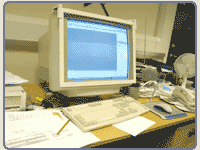


 



  
|

Taxonomy and description
Terminology
Use of ICT in activities other than work
Tele-Banking
Telemedicine
E-government
E-commerce
Technology
Terminology
 Telecommunication
– distance working Telecommunication
– distance working
Information and communication technology (ICT) provide a range of possibilities
to perform activities at a distance, including shopping, education, and
working. Telecommuting is often defined as arrangement for a salaried
worker to work from home or at a telework centre with remote supervision.
The definition does not cover self-employed, contract workers, field work,
off-shore information processing and teleconferencing or overtime work
at home. It is however important to point out that the diffusion of the
new ICT along with the changes in organization have increased the share
of these activities as well as telecommunication in the society with implications
for transport and land use.
A wide range of terminology has been to describe working arrangements
where a worker is separated in time and space from his permanent work
place. The common terminology during the 1980s covered telecommuting,
teleworking, location-independent work, telematics, flexiplace, satellite
offices, neighbourhood centres, telecottages, telecenters, remote working
and many others. In the 1990s, new concepts such as hot desking, hotelling
and motelling, and campus/university model organisations are being added
to the telework lexicon (Wood, 1997).
Wood provides taxonomy of alternative work environments that can be created
by applying telework principles. The following taxonomy relies heavily
on Wood’s version (European Telework Online an Internet portal for
teleworking, telecommuting, and related topics provides definitions for
telecommuting and other e-activities, http://eto.org.uk/.
Home-based telecommuting. Under this model home becomes a legitimate workspace.
Telecommuting can be preformed on a full-time basis, even though it is
most often preformed on a part-time basis, one or two days per week. However,
conversion of some home space into legitimate workspace raises many complex
issues, such as occupational health and safety, tax considerations or
workers' compensation and accident claims. At the individual level, the
use of homes as the centres of information-based work have increased rapidly.
Such initiatives require risk-taking by the individual, investment in
new technology, a home office and a reasonably high degree of computer
literacy and business ability. At the organisational level, the number
of home-based telecommuting schemes have increased significantly, although
not all have formally written telecommuting policies.
Teleworker, as distinct from telecommuter, describes a self-employed,
home-based information worker. Because the need to commute is eliminated,
a teleworker is free to live and work in any location. Teleworkers need
not be limited to the employment available in their communities as they
can bring their jobs with them.
Virtual Office. Terms such as “hot desking”, “hotelling”,
“motelling” and “campus” describe the transformation
of spatial arrangements of work. The key drive is to reduce office overheads
and facilities costs and disperse workers to get closer to the customer.
The reduced office space is shared on an advanced booking basis. Each
“hot desk” is a workstation that provides technological support
with computers, mobile telephones, faxes, etc. Recent research indicates
that in some businesses between fifty and eighty percent of office desk
space may be empty on any given day. Then the introduction of a virtual
office is a sound business decision. A small but increasing number of
high technology environment companies have adopted the virtual office
approach.
Satellite offices. The terms satellite office and neighbourhood centre
typically refer to the relocation of employees to a fringe-located, high-technology
office environment. Users in neighbourhood centres typically come from
a diverse range of organisations and rent these facilities. Cost saving
of high-rent office space is the drive behind this arrangement.
Telework centre, telecentre or telecottage is usually located in or in
the vicinity of a residential area facilitated by up-to-date telecommunication
facilities. Large high-tech companies have embraced this arrangement.
It can serve employees of a single or multiple firms. Geography rather
than business function is the determinant of the location of a telework
centre. Advantages of this arrangement are lower costs of office space,
lower levels of staff turnover, higher levels of job satisfaction and
improved quality of work life.
Mobile teleworkers. Recent statistics show a substantial number of workers
that effectively have no fixed office space and are entirely mobile information
workers. Savings on office overhead costs and the necessity to get close
to the customers have been the drive for the increase in the number of
fully mobile teleworkers.
The changes in IT and telecommunication technology is so fast and the
unfolding of information society is so swift that the precise implications
and impacts of this growth on telecommuting/teleworking is not yet fully
understood.
There are key strategic decisions for management such as which technologies
to invest in and who should pay for these, where to locate employees (in
a central office, in a satellite office, in a telecentre or in the home),
design of autonomy in work, control of output and performance measures.

Use of ICT in activities other than work
Many activities other than commuting to work have been affected by ICT.
Examples of these include:
Distance Learning, Tele-education
The existing telecommunications infrastructure is used for education,
training, and lifelong learning in five basic ways:
- Instructing with video;
- Gathering information from remote libraries and databases;
- Communicating using two-way asynchronous capabilities such as e-mail
and chat;
- Distance learning;
- Electronic transfer of instructional software and simulations.
Even though the quality of education at universities is still determined
by the intensity of face-to-face interactions, there are large-scale
experiences of “distant universities,” and regardless of
their quality they are now second-option forms of education. Distance
learning universities could play a significant role in the future.
Tele-Banking
As banks are offering on-line customer services and automated teller machines,
the consolidated bank branches continue as service centres, to sell financial
products to their customers through a personalised relationship. Thus
a system of branch office sellers, automated tellers, customer service-by
telephone, and online transactions constitutes the new banking industry.
Banks’ interest in Internet banking is due to its very low transaction
costs and that those who are most likely to use Internet banking constitute
attractive demographic and economic customer groups.
Telemedicine
ICT has affected health services in two complementary ways. On the one
hand on-line communications and high-resolution video transmission allow
for the distant interconnection of medical care. Computer and telephone
are now used for regular health checks. Neighbourhood healthcare centres
are supported by information systems to improve the quality and efficiency
of their service. Yet, on the other hand, in most countries major medical
complexes emerge in specific locales, generally in large metropolitan
areas. Such medical complexes are a major economic and cultural force
in the area and city where they are located.
E-government
ICT has affected the media through which governments are providing services
and public information and hence the promoted emergence of digital government,
as it is called. The scope of application of ICT to the function of government
is quite wide such as applications to services to support: public management
processes, policy makers, analysts and evaluators, complex public service
programmes and direct citizen contact. The purpose of digital government
is to overcome the barriers of time and distance to perform the business
of government when and where they are demanded. It can quickly transfer
funds, answer questions, collect and validate data and keep information
flowing smoothly within and outside government.

E-commerce
The difference between electronic commerce and physical commerce is the
modes of communication and the flow of information. The core of the difference
is the reduced cost of communicating, transmitting, and processing information.
Information about prices, products, and availability can be gathered by
visiting various sellers' web sites or by using “Intelligent agents”
that can gather and aggregate the necessary information. The OECD (2002)
has developed two definitions of electronic commerce transactions, based
on a narrower and a broader definition of communications infrastructure
and guidelines for their applications as presented in the following table.
Source OECD (2002)
| E-commerce transactions |
OECD definitions |
Guidelines for the interpretation of
the definitions |
| Broad Definition |
An electronic transaction is sale
or purchase of goods or services, whether between businesses, households,
individuals, governments, and other public or private organisations,
conducted over computer mediated networks. The goods and
services are ordered over those networks, but the payment and the
ultimate delivery of goods or services may be conducted on or off-line. |
Include: orders received or placed
on any online application used in automated transactions such as
Internet applications, EDI, Minitel or interactive telephone systems. |
| Narrow definition |
An internet transaction is the
sale or purchase of goods and services, whether between businesses,
households, individuals, governments, and other public or private
organisations, conducted over the Internet. The goods and
services are ordered over those networks, but the payment and the
ultimate delivery of goods or services may be conducted on or off-line. |
Include: orders received or placed
on any Internet application used in automated transactions such
as Web page, Extranets and other applications that run over the
Internet, such as EDI over the Internet, Minitel over the Internet,
or over any Web enable application regardless of how the Web is
accessed (e.g. through a mobile or a TV set, etc.).
Exclude: orders received or placed by telephone, facsimile
or conversational e-mail. |
A further taxonomy related to e-commerce is related to who is trading
with whom. The focus in literature has been on businesses and consumers.
That produces four options as follows:
- Business to Business (B2B) is the electronic commerce between companies.
This is by far the largest segment among the four.
- Business to Consumer (B2C) is the electronic business aimed at consumers.
- Consumer to Business (C2B) is the reverse of B2C
- Consumer to Consumer (C2C) is the electronic commerce between individual
consumers.

E-commerce is mainly concentrated in the first two categories: B2B and
B2C.
The ICT is introducing increasingly new products and services, some real
and some virtual and has dramatically affected how business is being transacted.
There is a transition from the traditional marketplace to the electronic
marketplace. This transition is happening at three levels of economic
activity.
- The first level is that the products and services are reshaped to
accommodate an electronic marketplace whose important characteristics
are that they are information-based.
- The second level is marketing management systems. Businesses organise
their selling efforts via systems that are significantly different from
those in current use.
- Finally the markets themselves are affected as a result of the first
two levels.
- The ability to satisfy consumers in the electronic marketplace implies
faster product delivery, higher potential frequency of delivery, greater
flexibility and lower costs. Associated with e-commerce are reduced
inventories and a related reduction of risk of obsolete inventories
as the demand for goods and services are electronically linked through
just-in-time inventory and integrated manufacturing techniques.
Technology
 Telephone
and Personal Computers (PCs) are the most common technologies used by
telecommuters. Modem and fax machines are also quite popular. Although
the telecommunication services and equipments available seem to be adequate
for most current telecommuting, a more advanced telecommunication infrastructure
would be important in promoting the future growth and sophisticated use
of telecommunication. These include wide-bandwidth services for video
functions and transfer of very large quantities of data. Telephone
and Personal Computers (PCs) are the most common technologies used by
telecommuters. Modem and fax machines are also quite popular. Although
the telecommunication services and equipments available seem to be adequate
for most current telecommuting, a more advanced telecommunication infrastructure
would be important in promoting the future growth and sophisticated use
of telecommunication. These include wide-bandwidth services for video
functions and transfer of very large quantities of data.
A more advanced telecommunications infrastructure is also the key to
the promotion of the use of ICT by businesses, government and in other
societal uses.

|




